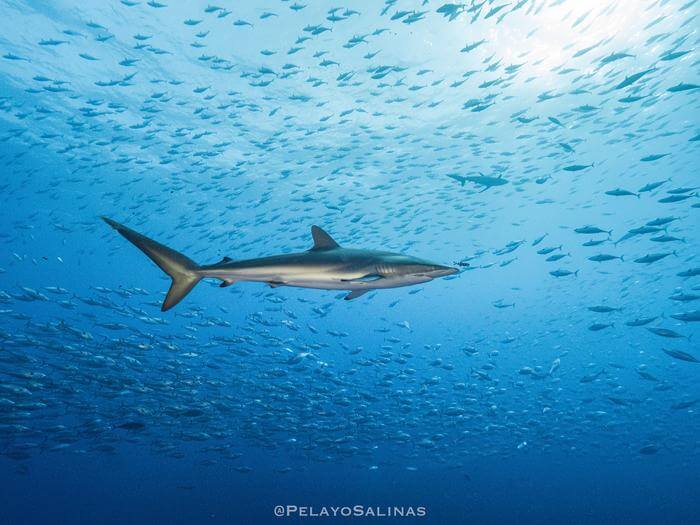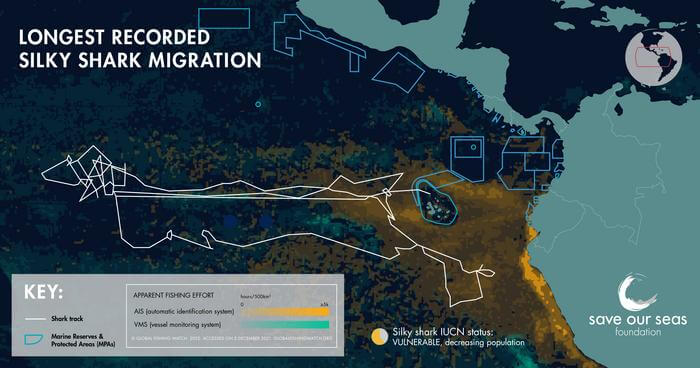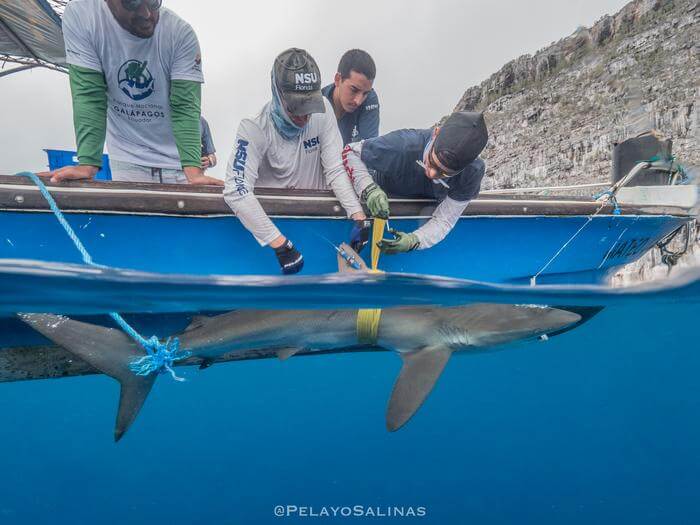PUERTO AYORA, Ecuador — Scientists were stunned when they tracked a shark named Genie migrating an astounding 27,666 kilometers (over 17,000 miles) across the Pacific Ocean over a year and a half. This marathon journey shattered the previous long-distance migration record for her species by nearly six times!
The incredible voyage by this silky shark highlights how these iconic ocean predators freely roam vast expanses of the open seas, paying no mind to the invisible national boundary lines drawn on maps by humans. Genie’s epic trek, which would be like driving across the United States coast-to-coast four times, is also providing critical insights into the behavior and migration patterns of this vulnerable shark species.
More importantly, researchers say it’s highlighting the urgent need for coordinated international efforts to protect endangered sharks and other species that migrate through the ocean.
“Sharks have been roaming the world’s oceans for hundreds of millions of years and the map boundaries we humans have established on paper mean nothing to them,” says Dr. Pelayo Salinas de León, lead author of the study published in the Journal of Fish Biology. “Their long migrations through heavily fished international waters expose them to significant risks, highlighting the need for a coordinated global response to ensure the survival of this highly threatened group of species.”

In July 2021, researchers from the Charles Darwin Foundation and partners in the Galapagos Islands attached a satellite tracking device to the fin of an adult female silky shark. They nicknamed her Genie, after the late marine biologist Eugenie Clark.
For the next 546 days, Genie’s coordinates periodically pinged back to the scientists as she swam a whopping 27,666 km (17,181 miles). Her route took her over 4,700 km (2,900 miles) west towards Hawaii across a vast stretch of international waters, then looped back towards the Galapagos twice.
At times, the six-foot shark was cruising at over 50 km (31 miles) per day, much faster than other tracked shark species her size.

So, why do sharks travel so incredibly far during their migrations? There are actually several reasons:
Feeding: Many shark species migrate to take advantage of abundant food sources. For example, they may move to areas rich in fish, seals, or other prey as these populations fluctuate seasonally. This migration is often driven by the movement of their prey. Simply put, Genie may have traveled to where her food was traveling.
Breeding: Reproduction is another significant reason for migration. Sharks may travel extremely long distances to reach specific breeding sites, just like salmon swimming upstream to reach the original river they were born in.
Environmental Conditions: Sharks may also migrate to find optimal water temperatures and habitat conditions. Seasonal changes in sea temperature can affect their metabolic rates and other biological processes, prompting them to move to warmer or cooler waters depending on their needs. Therefore, Genie may have planned her Hawaiian vacation for the same reason people do — the weather.
Conservation of Energy: In some cases, migrations are part of the shark’s strategy to conserve energy. By moving to areas with favorable ocean currents, sharks can reduce the amount of energy needed for long-distance travel.

What made Genie’s trek so astounding is that for over 99 percent of the time, she swam through international waters far outside any nation’s territorial waters or protected areas. These vast open ocean areas have minimal fishing regulations, putting migrating sharks at high risk from overfishing and hunters seeking their fins.
“This finding is a call to action for all stakeholders involved in marine conservation and fisheries management to work together to protect these iconic species and the oceanic ecosystems they inhabit,” says Dr. Mahmood Shivji, co-author of the study.
Silky sharks are particularly vulnerable because of their biological makeup. They mature slowly, have relatively few pups, and are in high demand for their fins in the global shark fin trade despite being classified as “Vulnerable” by the International Union for Conservation of Nature. Currently, nations only have jurisdiction over waters within 200 miles of their coastlines.
“Understanding the migratory pathways of silky and other threatened pelagic sharks is crucial for developing effective management strategies to revert ongoing global population declines,” says Dr. Salinas de León.
StudyFinds Editor Chris Melore contributed to this report.
